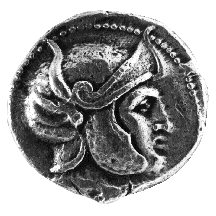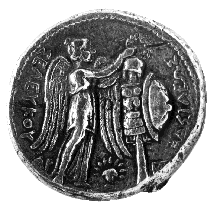



(49) Syria, Seleukos I Nikator - AR tetradrachm, c. 301 B.C.?,
17.0 g. (inv. 91.089).
Obverse: Head of Seleukos or Alexander r., wearing helmet
of leopardskin adorned with horn and ear of bull.
Reverse: Nike crowning trophy of armor r.; head of Helios
below; monogram in r. field; ![]()
![]() : of King Seleukos.
: of King Seleukos.
Provenance: Hesperia Art, 1961.
Bibliography: R.A. Hadley, "Seleucus, Dionysos, or
Alexander?," Numismatic Chronicle 1974, 9-13; O. Mørkholm,
Early Hellenistic Coinage from the Accession of Alexander to the Peace
of Apamea (336-188 B.C.) (Cambridge 1991) 72.
Seleukos I Nikator (Conqueror) was one of the generals of Alexander the
Great and assumed control of Babylon after Alexander's death. By degrees
he became ruler of Alexander's eastern dominions, with the exception of
Egypt, defeating his rivals Demetrios and Lysimachos. In 305/04 B.C. he
assumed the title of basileus or king. Like the other successors
of Alexander, Seleukos I initially issued coins with the types used in Alexander's
coinage, but like the others also he soon issued coins with his own types
and in his own name.
The date and even the interpretation of these tetradrachms that he issued
at Susa are uncertain. The youthful head on the obverse may be an idealized
head of Seleukos incorporating some aspects of Alexander's portrait, but
it has also been suggested that it is Alexander himself. The leopardskin
of the
helmet refers to the god Dionysos, whose attribute was a leopard and who,
like Alexander and Seleukos, conquered India. The helmet recalls the lionskin
cap worn by Herakles on coins of Alexander, and the bull's ear and horn
recall similar divine attributes in portraits of Alexander (see no. 45).
The reverse has also been variously interpreted. The trophy crowned by Nike
consists of a tree trunk hung with a cuirass or breastplate, a helmet, and
a shield, clear references to military victory. It is usually taken to refer
to Seleukos' important victory over Antigonos Monophthalmos at the Battle
of Ipsos in 301 B.C., but it has also been seen as a generalized reference
to Alexander's and Seleukos' Indian victories.
K.J.B.



All contents copyright (c) 1996.
Lawrence University
All rights reserved.